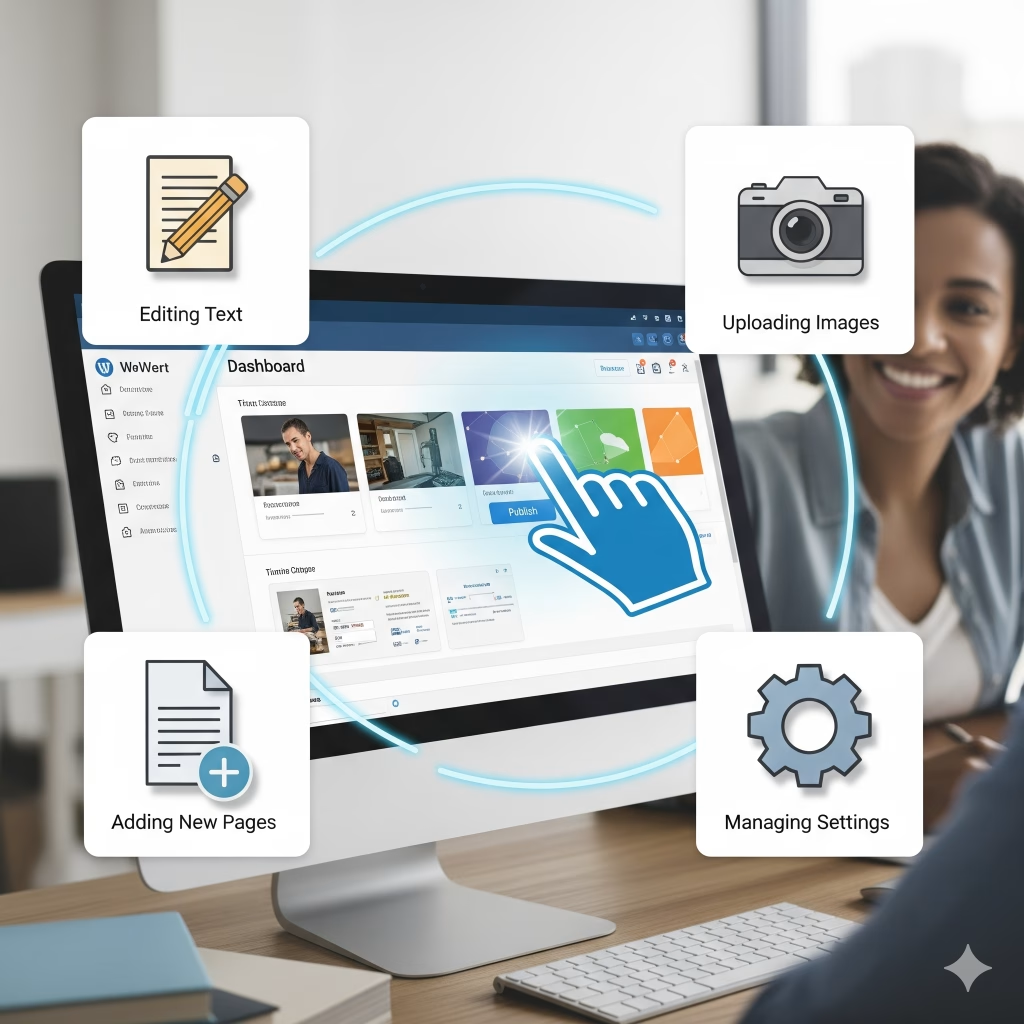You can manage the content yourself after launch if your site is built with WordPress or any modern content management system (CMS). This is one of the biggest advantages of using a CMS: it puts control directly in your hands. You don’t need to rely on a developer every time you want to update text, add images, post a blog, or make changes to your pages.

The interface is designed to be user-friendly, even for non-technical users. Once your site is live, you’ll have access to a dashboard where you can easily edit content, upload media, manage menus, and more. Whether you’re updating product details, publishing news, or making seasonal changes to your homepage, the process is fast and intuitive.
We also provide a basic walkthrough or training session (if needed) so you feel confident navigating the system. You’ll learn how to make common updates, work with templates or blocks, and manage your content without breaking anything. And if you prefer written documentation, we can provide that too — tailored to your specific site setup.
🛠️ Tools That Make It Easier
- Elementor / WPBakery: Drag-and-drop page builders
- Advanced Custom Fields (ACF): Structured fields for easy editing
- Yoast SEO / RankMath: Add SEO meta titles, descriptions
- Media Library Organizer: Manage images by folders
Some business owners worry that taking control of their own website content will require steep learning curves or hours of training, but the reality is that modern platforms are designed with usability in mind, and most clients become comfortable within the first few sessions of hands-on experience. Developers often provide a one-time training session during handover, walking you through the dashboard, showing you how to edit pages, update menus, and manage plugins. For those who want additional support, there are countless free resources, documentation, and video tutorials on platforms like YouTube and professional forums where users share advice, troubleshooting tips, and advanced customization techniques. This means that you never feel locked into a dependency relationship with your developer—though you may still choose to collaborate on major upgrades, design overhauls, or technical security measures,
🎓 Final Answer:
Yes, you can easily manage your site’s content yourself after launch using WordPress’s built-in admin dashboard so no coding needed.
MORE LINKS:
What is wordpress?
WordPress theming.
AI chatbot installation
Recommend a CMS
WordPress for eshop
Who owns the CMS?
Updating wordpress
Install plugins
WordPress security
MANAGE THE CONTENT MYSELF
At Wemaxa, we believe in empowering our clients to own their platforms. Whether you want full creative control or just the ability to make small tweaks, your site is built to give you that freedom without requiring ongoing technical support. And if you ever need help, we’re just a message away.
One of the most frequent questions clients ask during the web development process is whether they will be able to manage their website content on their own after launch, without having to depend on a developer for every update, and the short answer is yes, absolutely, because modern content management systems are specifically designed to empower business owners, marketers, bloggers, and entrepreneurs to maintain control over their digital presence without needing to understand complex programming languages or advanced web technologies. With a user-friendly dashboard, intuitive editing tools, drag-and-drop functionality, and clear navigation menus, platforms like WordPress allow you to log in securely, make changes in real time, preview them instantly, and publish them across your site with minimal effort, whether you want to update product descriptions, add new service pages, upload fresh images, adjust menus, or even embed multimedia like videos and podcasts. This independence is critical for businesses that want to stay competitive online because waiting days or weeks for a developer to fix a small typo or publish a new announcement can cost you visibility, sales opportunities, and credibility in front of your audience, while managing the content yourself keeps the site current, relevant, and aligned with fast-moving market demands.

The real value of being able to manage your own website content lies in the flexibility it provides when it comes to scaling your operations, adapting to industry trends, and responding to customer feedback. Imagine running a small e-commerce store where product availability changes daily—without self-management capabilities, you would have to depend on a third party to update stock levels, publish promotions, or remove outdated listings, which is inefficient and costly. By contrast, when your site is built on a system like WooCommerce integrated with WordPress, you have direct access to your product catalog, can adjust prices during a sale, add seasonal discounts, or modify shipping options instantly, giving you the ability to respond to market shifts as they happen. Similarly, a service-based business such as a consultancy or design studio benefits from updating case studies, testimonials, and blog posts as new projects are completed, which improves search engine optimization (SEO), builds authority in your niche, and demonstrates credibility to potential clients. Being able to manage this content yourself means you control your narrative, ensuring your digital presence always reflects the latest version of your business and your values, which is crucial for long-term growth and customer trust.
📌 Things You Might Still Need Help With
| Task | Why |
|---|---|
| Theme changes | May involve custom code or child themes |
| Plugin conflicts | Can break layouts or cause errors |
| Performance optimization | Caching, database cleanup, CDN setup |
| Security/hardening | Requires deeper server/WordPress knowledge |
Another important dimension of post-launch content management is the integration of search engine optimization strategies, which can be applied directly through tools and plugins that make technical processes simple and approachable even for non-experts. For example, the Yoast SEO plugin for WordPress allows you to optimize your content with keyword analysis, readability checks, structured metadata, and XML sitemaps without writing any code. This means you can publish new articles, landing pages, and product descriptions that are not only visually appealing but also optimized for ranking on Google, Bing, and other search engines. This independence ensures you are not at the mercy of an agency or developer for ongoing visibility, giving you a cost-effective way to continuously enhance your online presence. Beyond SEO, many content management systems integrate with marketing tools, analytics dashboards, and customer relationship management (CRM) software, enabling you to track performance, monitor audience engagement, and refine your strategy based on real data. Having the autonomy to execute and adjust these elements directly inside your site makes managing the content after launch an essential skill for business owners who want to maximize their digital footprint while keeping costs predictable.
✅ What You Can Manage Yourself (No Coding Required)
| Task | Where You Do It | Example |
|---|---|---|
| 📝 Add/Edit Pages & Posts | Pages → Add New / Posts → Add New | Update text, images, links |
| 📷 Upload Media | Media → Add New | Add images, PDFs, videos |
| 🧱 Change Layout/Blocks | Block Editor (Gutenberg) or Page Builder | Move sections, add new rows |
| 📅 Manage Blog or News | Posts | Add new articles or updates |
| 🔗 Menus & Navigation | Appearance → Menus | Rearrange or add new links |
| 🖼️ Change Homepage Sections | Appearance → Customize or via page | Update banners, CTAs, text |
| 🔐 Manage Users | Users → Add New | Assign roles: editor, admin, etc. |


